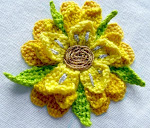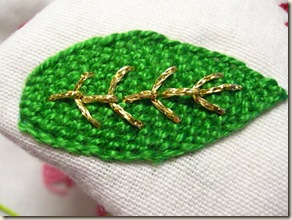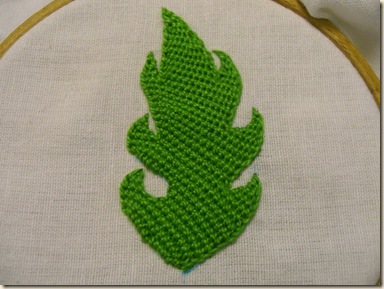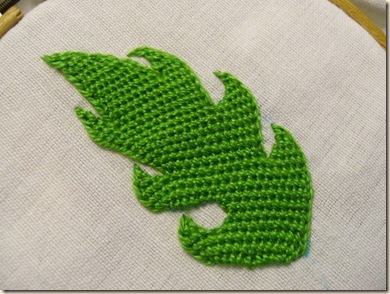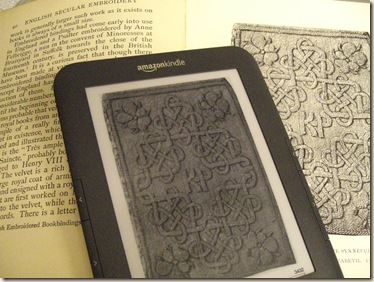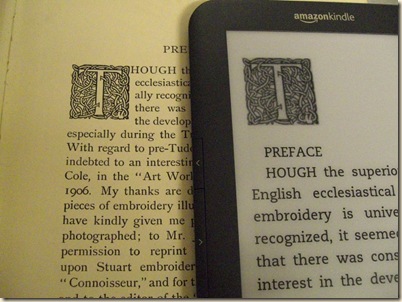The book was returned by the publisher for signing off and consequently threw my progress with St Katherine out of sync. Then, for some strange reason I noticed I now have a mountain of mending, including altering 2 sets of curtains! However, in all of that I managed to return to a particular conundrum and apply some clearer thinking…
Detached Buttonhole Leaf stitched on the bias
In August I was studying leaf formation, especial sharp points and serrated edges on period pieces.
I said then that I wasn’t happy with the version below but have since changed my mind and accept and stand by what I said in the Summer about stitching DBH directly and outlining the shapes afterwards:
Especially as someone – who has to remain anonymous – sent me a super large image of a period flower motif that you can clearly see has been stitched directly and neatly, without outlining beforehand. It certainly fits in very much with certain configurations of thread that I can see on the images I have access to.
That brings me back to a particular (blue) leaf that I keep returning to but have been unable to figure out. It seems that now finally, I have made some progress.
I took a fresh look at it and realised it could not have been stitched in the normal way. By that I mean it must have been stitched on the bias, or diagonally.
The reason I think they did that was because you find very quickly when attempting more complex shapes that if you start at a narrow pointed end, like the base of a leaf say, you end up having to stretch the tiny piece of fabric that you create too much. Comparing period pieces, you can see their work was not stretched in this way, but rather fuller and more compact. So I’ve found that its better to begin with a greater number of stitches. In so doing, this makes creating points and later decreasing them, much easier. Funny how when you begin to notice shapes worked that way, you suddenly end up seeing a lot of more them.
So these next pictures are pretty self-explanatory.
Below you can see how I started the leaf on the bottom left hand side with a cording row onto which I placed roughly 14 stitches.
The shape is not outlined beforehand but when I completed it, I stem stitched some outer edges as discussed before.
What was different with this figure was, as I stitched I held the work in this position. This made the whole thing a lot easier and much faster.
When I came to work the points, I extended the tips even more by finishing them off with a detached chain stitch, as I can see they have done on the original.
Old Books and Kindle Downloads
When it comes to choosing an e-reader, the choice is mainly between a Kindle or an i-Pad.
I chose Kindle because as an e-reader, it has zero glare.
I planned to download lots of really old, out of print, black & white books, like A History of Secular Embroidery by M Jourdain:
‘The Internet Archive’ website (sorry no links at this time, but you can Google it) is marvellous for offering Kindle format versions that you can download as a Mobi file, then send to yourself via your Kindle email account – the whole process is lightening quick. The illustrations come out really well but as I said, I bought it mainly for text.
If I had bought an i-Pad, as its a device that displays colours, I could start say, buying craft books as e-books and save a lot of space but the i-Pad is a lot more than an e-reader and is basically another computer screen. So, simply to read large amounts of text, I came back to my Kindle.
I find, especially when my eyes are tired, the last thing I can cope with is any kind of glare. Furthermore, you can increase the font size as a default setting for all your books. Added to which, its one-armed reading in bed!
Recently I extended that idea and bought a leather cover by Tuff-Luv which includes a hands-free stand in guess what colour….cherry yoghurt pink!
While I still had the original 1910 book out of the library I was able to compare the downloaded file to it for possible discrepancies and formatting compromises. I was pleased to note that there was very little ‘lost in translation’, as it were.
The only thing to remember when selecting which version of a book to download, is that early Kindle conversion files tend to be not as smooth, so you should select copies that indicate how popular they are by the number of times they have been downloaded.
Gotta go ppl!

